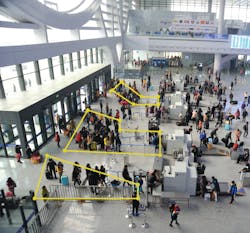For years, video analytics were supposed to be the next big thing in video security. The promise of detecting when a bag is left behind or when a terrorist on a watch list enters an airport lured many into the world of video analytics.
Unfortunately, video analytics technology did not deliver on these promises, and the number of false-positives forced many security managers to simply turn the analytics off. While many video analytic companies came and went, the few initial successes with analytics were built around motion detection, such as trip wire, loitering, direction and various other advancements around the technology. These implementations targeted perimeter protection with the objective of generating an automated alert when the perimeter was breached. The perimeter in these cases is defined as a fence, a window, a door, or any building or area that you are trying to protect.
Well, things haven’t changed all that much over the years. Motion-based analytics are still the most widely-used video analytics because they solve a basic problem: “Alert me when someone has breached the perimeter.”
Motion Analytics for Perimeter Protection
Integrators need to ask their customers what problem it is that they are trying to solve. If the customer is installing a security system to protect a business after hours, then basic motion detection may be all that is required. If the customer wants to protect certain areas of a building, then a more advanced solution will usually be required. For example, if the customer wants to be alerted anytime someone enters a specific area, a trip wire analytic is often a good solution, since it won’t interfere with the rest of the scene.
If the customer is concerned about someone entering an exit point, a directional motion analytic will alert the security officer when someone is going the wrong way. This approach can also be used for vehicles as well. Some newer motion analytics can actually “learn” the landscape and alert if any motion out of the ordinary occurs, such as a person walking on a freeway. It all comes down to understanding the actual customer problem and then applying the right type of motion analytic for the situation.
Searching for Evidence
The majority of video security installations are not monitored by security personnel. Most DVRs and VMS systems are used for reactionary purposes, such as, for example, when the system provides evidence of a fraudulent, criminal or other event that requires an investigation. For banks and retailers in particular, this is a common occurrence. To serve this sector of the market, “forensic search” analytics can be used to automate the tedious and often voluminous task of searching for evidence. Forensic search analytics are able to mine video for motion, color, speed, direction, license plates and other parameters, generating meaningful metadata that can be searched.
This enables investigators to reduce the amount of time it takes to search through video for specific information or when looking for a suspect. For example, the search for a young male suspect wearing a red shirt and headed west through a building can be narrowed down to a small subset of suspects. This is achieved by using a demographics analytic that can determine the gender and age range of a suspect, plus analytics that can detect color and direction. Combining these together into a search parameter is akin to searching the Internet where you may have thousands of possibilities (or more) and the top 10 results are presented on the first page.
The addition of face detection and indexing takes this a step further, enabling an investigator to identify video of a suspect on one camera, and search through 30 days of video through all the cameras, even across the enterprise, to find other related video on the suspect. If you are an integrator and have a customer that uses their VMS for investigations, you can save the customer significant time and money by reducing search times by installing a video security system that uses analytics to search for information in the video. You can demonstrate the return on investment (ROI) by reducing the time and resources required for these types of searches.
Retail Analytics – New Opportunities for Integrators
The challenge of early stage video analytics technology was that the analytics needed to be highly accurate — almost perfect — to achieve the results that analytic companies touted. No security team wants to constantly address false alarms. But, in a retail environment, the analytics don’t have to be as accurate when used for business intelligence. If the analytics are able to count people entering and exiting doors with a +/- 10% accuracy, over time the results can be very valuable. Consequently, adoptions of video analytics solutions are growing in the retail industry, presenting a strong business opportunity for skilled integrators. Even though this opportunity may be new to traditional security integrators, the skills required to install a system are almost the same as a typical security install.
Retail analytics can identify the age and gender of customers, track traffic patterns, measure how long customers dwell in certain areas and provide heat maps to show where customers are spending the most time in the store. The results are generally provided online in the form of reports and graphs that can be accessed by the store manager or corporate operations and marketing teams to help gauge the success of advertising campaigns, optimize store layouts and better understand customers. Editor’s Note: Read more about retail analytics on page xx of this issue.
Audio Analytics
One type of analytic has been under-utilized and frequently misunderstood: audio. Why would an integrator ever need to deploy audio analytics? Imagine that your customer is a new car dealership with one lone security guard working the night shift. Audio analytics do a very good job of detecting glass breakage and car alarm detection while filtering out all the other ambient noise one might hear on a busy street. Perhaps the lot has been using motion analytics and getting a lot of false-positive alerts. By combining the analytics into a single alert, you can reduce the number of unwanted alerts by only alerting when there is both motion and sound.
Audio analytics can also be used for gunshot detection, shouting and aggression, and can even detect a key word that, when spoken in an emergency or robbery, will trigger an alarm.
Whether you are selling to financial institutions concerned with fraud prevention or retailers interesting in gaining a better understanding of their customers and store operations, remember to start by asking your customer what problem they are trying to solve. In this way, you can implement the right type of video analytics to deliver a valuable and successful solution.
Brian Lane is Director of Product Marketing for 3VR. To request more info about the company, please visit www.securityinfowatch.com/10215729.



